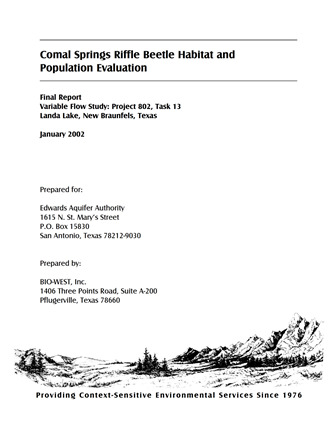Comal Springs Riffle Beetle Habitat and Population Evaluation/ Final Report Variable Flow Study: Project 802, Task 13 Landa Lake, New Braunfels, Texas

| Summary |
|
BIO-WEST conducted three samples for riffle beetles in the Comal system to document potential areas where the Comal Springs riffle beetle (Heterelmis comalensis) might occur, but which had not been sampled in prior work. In addition, this study involved quantitative samples in an attempt to produce limited estimates of the H. comalensis population in areas sampled and to compare results with earlier work by D. Bowles of Texas Parks and Wildlife Department (TPWD). In that study, a maximum of 2.5 H. comalensis per m2 was observed in spring run 3. Though the quantitative samples in this study were not gathered in the same random manner, it provides some means of comparison for the preferred habitat in which we focused our samples. The first sample was conducted during summer 2001 (26-28 June) and primarily involved exploring the western shoreline of Landa Lake. That sample resulted in confirmation of the Comal Springs riffle beetles in a habitat far removed from the 3 spring runs in which it was previously believed to be restricted. The second sample occurred during fall 2001 (19-20 September) with additional sampling conducted during the first week of October. The result of this sample was to document the existence of Comal Springs riffle beetles in 2 areas of Landa Lake where springflow was clearly issuing from springs in the bottom substrate. In addition, quantitative samples were taken along the Landa Lake shoreline and in spring run 3; however, quantitative sampling was not as detailed as anticipated due to time constraints. The final sample occurred during winter (2-3 January 2002) and expanded on information gathered in the earlier samples, including additional quantitative sampling. The first sample was focused entirely on exploring various habitats; thus no quantitative sampling was conducted. Our limited sampling during the second sample (fall 2001) resulted in an estimate of 2.0 adult H. comalensis per square meter in the shoreline habitat most distant from the spring runs, and 0.25 H. comalensis per square meter in spring run 3 (the latter is suspected to be underestimated). In the winter sample, we observed a similar number of adult H. comalensis in the shoreline habitat removed from the spring runs (2.0 per m2), but more H. comalensis were observed in spring run 3 than in the earlier trip (2.0 per m2). From these findings, we can conclude that the Comal Springs riffle beetle is more widespread in the Comal Springs ecosystem than previously thought; it is not restricted to the spring runs. In fact, the population that was found along the shoreline habitat had similar densities of H. comalensis as that observed in spring run 3. These findings suggest that the habitat requirements for the species may not be as restrictive as is currently believed by the USFWS and others, but more study is needed during low-flow conditions. We did observe that the species was not typically found in areas where silt accumulated on top of the rocks, and were generally found only in areas where springflow was evident during the flow conditions that occurred during this study. Because low-flow conditions did not occur during the sampling protocol, we were unable to determine if the beetles remain in areas where springflow is reduced or ceases entirely with decreasing total springflow. |
Search for Documents
Advance Search
Explore EAA's Scientific Reports
- All Reports
- Groundwater Movement
- Geomorphology and Caves
- Weather Modification
- Geology
- Water Use and Conservation
- Geochemistry
- Water Resources Planning and Management
- Floods and Drought
- Water Quality
- Climatology
- Surface Water / Groundwater Relationship
- Biology
- Springs, Groundwater Discharge
- Archaeology
- RZ Protection
- Aquifer Levels
- Remote Sensing
- Precipitation
- Overview Studies
- Modeling
- Hydrology and Hydrogeology
- History
- Groundwater Recharge, Recharge Zone
